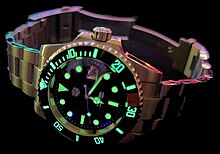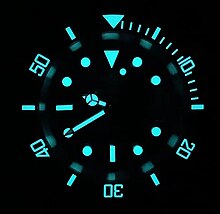Informatics Educational Institutions & Programs
Contents

| |
| Names | |
|---|---|
| IUPAC name
Strontium aluminate
| |
| Identifiers | |
3D model (JSmol)
|
|
| ECHA InfoCard | 100.031.310 |
| EC Number |
|
PubChem CID
|
|
CompTox Dashboard (EPA)
|
|
| |
| |
| Properties | |
| SrAl2O4 | |
| Molar mass | 205.58 g/mol |
| Appearance | Pale yellow powder |
| Density | 3.559 g/cm3 |
| Structure | |
| Monoclinic | |
Except where otherwise noted, data are given for materials in their standard state (at 25 °C [77 °F], 100 kPa).
| |
Strontium aluminate is an aluminate compound with the chemical formula SrAl2O4 (sometimes written as SrO·Al2O3). It is a pale yellow, monoclinic crystalline powder that is odourless and non-flammable. When activated with a suitable dopant (e.g. europium, written as Eu:SrAl2O4), it acts as a photoluminescent phosphor with long persistence of phosphorescence.
Strontium aluminates exist in a variety of other compositions including SrAl4O7 (monoclinic), Sr3Al2O6 (cubic), SrAl12O19 (hexagonal), and Sr4Al14O25 (orthorhombic). The different compositions cause different colours of light to be emitted.
History
Phosphorescent materials were discovered in the 1700s, and people have been studying them and making improvements over the centuries. The development of strontium aluminate pigments in 1993 was spurred on by the need to find a substitute for glow-in-the-dark materials with high luminance and long phosphorescence, especially those that used promethium. This led to the discovery by Yasumitsu Aoki (Nemoto & Co.) of materials with luminance approximately 10 times greater than zinc sulfide and phosphorescence approximately 10 times longer, and 10 times more expensive. The invention was patented by Nemoto & Co., Ltd. and licensed to other manufacturers and watch brands.[1] Strontium aluminates are now the longest lasting and brightest phosphorescent material commercially available.
For many phosphorescence-based purposes, strontium aluminate is a superior phosphor to its predecessor, copper-activated zinc sulfide, being about 10 times brighter and 10 times longer glowing.[citation needed] It is frequently used in glow in the dark objects, where it replaces the cheaper but less efficient Cu:ZnS that many people recognize with nostalgia – this is what made 'glow in the dark stars' stickers glow.
Advancements in understanding of phosphorescent mechanisms, as well as advancements in molecular imaging, have enabled the development of novel, state-of-the-art strontium aluminates.[2]
Properties
Strontium aluminate phosphors produce green and aqua hues, where green gives the highest brightness and aqua the longest glow time. Different aluminates can be used as the host matrix. This influences the wavelength of emission of the europium ion, by its covalent interaction with surrounding oxygens, and crystal field splitting of the 5d orbital energy levels.[3]


The excitation wavelengths for strontium aluminate range from 200 to 450 nm, and the emission wavelengths range from 420 to 520 nm. The wavelength for its green formulation is 520 nm, its aqua, or blue-green, version emits at 505 nm, and its blue emits at 490 nm. Strontium aluminate can be formulated to phosphoresce at longer (yellow to red) wavelengths as well, though such emission is often dimmer than that of more common phosphorescence at shorter wavelengths.
For europium-dysprosium doped aluminates, the peak emission wavelengths are 520 nm for SrAl2O4, 480 nm for SrAl4O7, and 400 nm for SrAl12O19.[4]
Eu2+,Dy3+:SrAl2O4 is important as a persistently luminescent phosphor for industrial applications. It can be produced by molten salt assisted process at 900 °C.[5]
The most described type is the stoichiometric green-emitting (approx. 530 nm) Eu2+:SrAl2O4. Eu2+,Dy3+,B:SrAl2O4 shows significantly longer afterglow than the europium-only doped material. The Eu2+ dopant shows high afterglow, while Eu3+ has almost none. Polycrystalline Mn:SrAl12O19 is used as a green phosphor for plasma displays, and when doped with praseodymium or neodymium it can act as a good active laser medium. Sr0.95Ce0.05Mg0.05Al11.95O19 is a phosphor emitting at 305 nm, with quantum efficiency of 70%. Several strontium aluminates can be prepared by the sol-gel process.[6]
The wavelengths produced depend on the internal crystal structure of the material. Slight modifications in the manufacturing process (the type of reducing atmosphere, small variations of stoichiometry of the reagents, addition of carbon or rare-earth halides) can significantly influence the emission wavelengths.
Strontium aluminate phosphor is usually fired at about 1250 °C, though higher temperatures are possible. Subsequent exposure to temperatures above 1090 °C is likely to cause loss of its phosphorescent properties. At higher firing temperatures, the Sr3Al2O6 undergoes transformation to SrAl2O4.[7]
Cerium and manganese doped strontium aluminate (Ce,Mn:SrAl12O19) shows intense narrowband (22 nm wide) phosphorescence at 515 nm when excited by ultraviolet radiation (253.7 nm mercury emission line, to lesser degree 365 nm). It can be used as a phosphor in fluorescent lamps in photocopiers and other devices. A small amount of silicon substituting the aluminium can increase emission intensity by about 5%; the preferred composition of the phosphor is Ce0.15Mn0.15:SrAl11Si0.75O19.[8]
However, the material has high hardness, causing abrasion to the machinery used in processing it; manufacturers frequently coat the particles with a suitable lubricant when adding them to a plastic. Coating also prevents the phosphor from water degradation over time.
The glow intensity depends on the particle size; generally, the bigger the particles, the better the glow.
Strontium aluminate is insoluble in water and has an approximate pH of 8 (very slightly basic).
Structural material
Strontium aluminate cement can be used as refractory structural material. It can be prepared by sintering of a blend of strontium oxide or strontium carbonate with alumina in a roughly equimolar ratio at about 1500 °C. It can be used as a cement for refractory concrete for temperatures up to 2000 °C as well as for radiation shielding. The use of strontium aluminate cements is limited by the availability of the raw materials.[9]
Strontium aluminates have been examined as proposed materials for immobilization of fission products of radioactive waste, namely strontium-90.[10] Europium-doped strontium aluminate nanoparticles are proposed as indicators of stress and cracks in materials, as they emit light when subjected to mechanical stress (mechanoluminescence). They are also useful for fabricating mechano-optical nanodevices. Non-agglomerated particles are needed for this purpose; they are difficult to prepare conventionally but can be made by ultrasonic spray pyrolysis of a mixture of strontium acetylacetonate, aluminium acetylacetonate and europium acetylacetonate in reducing atmosphere (argon with 5% of hydrogen).[11]
Industrial and commercial applications

Strontium aluminate based afterglow pigments are marketed under numerous brand names such as Core Glow, Super-LumiNova[12] and Lumibrite, developed by Seiko.
Many companies additionally sell products that contain a mix of strontium aluminate particles and a 'host material'. Due to the nearly endless ability to recharge, strontium aluminate products cross many industries. Some of the most popular uses are for street lighting, such as the viral bike path.[13]
Companies offer an industrial marble aggregate mixed with the strontium aluminate, to enable ease of using within standard construction processes. The glowing marble aggregates are often pressed into the cement or asphalt during the final stages of construction.
Reusable and non-toxic glow stick alternatives are now being developed using strontium aluminate particles.
Cubic strontium aluminate can be used used as a water-soluble sacrificial layer for the production of free-standing films of complex oxide materials.[14][15]
Safety
Strontium aluminates are considered non-toxic, and are biologically and chemically inert.[16]
Care should be used when handling loose powder, which can cause irritation if inhaled or exposed to mucous membranes.[16]
References
- ^ United States Patent 5,424,006 'Phosphorescent phosphor'
- ^ Inan Akmehmet, Guliz; Šturm, Sašo; Komelj, Matej; Samardžija, Zoran; Ambrožič, Bojan; Sezen, Meltem; Čeh, Miran; Ow-Yang, Cleva W. (2019-11-01). "Origin of long afterglow in strontium aluminate phosphors: Atomic scale imaging of rare earth dopant clustering". Ceramics International. 45 (16): 20073–20077. doi:10.1016/j.ceramint.2019.06.271. ISSN 0272-8842.
- ^ Dutczak, D.; Jüstel, T.; Ronda, C.; Meijerink, A. (2015). "Eu2+ luminescence in strontium aluminates". Phys. Chem. Chem. Phys. 17 (23): 15236–15249. Bibcode:2015PCCP...1715236D. doi:10.1039/C5CP01095K. hdl:1874/320864. PMID 25993133. S2CID 13801803.
- ^ Katsumata, Tooru; Sasajima, Kazuhito; Nabae, Takehiko; Komuro, Shuji; Morikawa, Takitaro (20 January 2005). "Characteristics of Strontium Aluminate Crystals Used for Long-Duration Phosphors". Journal of the American Ceramic Society. 81 (2): 413–416. doi:10.1111/j.1151-2916.1998.tb02349.x.
- ^ Rojas-Hernandez, Rocío Estefanía; Rubio-Marcos, Fernando; Gonçalves, Ricardo Henrique; Rodriguez, Miguel Ángel; Véron, Emmanuel; Allix, Mathieu; Bessada, Catherine; Fernandez, José Francisco (19 October 2015). "Original Synthetic Route To Obtain a SrAlO Phosphor by the Molten Salt Method: Insights into the Reaction Mechanism and Enhancement of the Persistent Luminescence". Inorganic Chemistry. 54 (20): 9896–9907. doi:10.1021/acs.inorgchem.5b01656. PMID 26447865.
- ^ Misevičius, Martynas; Jørgensen, Jens Erik; Kareiva, Aivaras (2013). "Sol-Gel Synthesis, Structural and Optical Properties of Cerium-Doped Strontium Aluminates, Sr3Al2O6 and SrAl12O19". Materials Science. 19 (4). doi:10.5755/j01.ms.19.4.2670.
- ^ Liu, Yun; Xu, Chao-Nan (May 2003). "Influence of Calcining Temperature on Photoluminescence and Triboluminescence of Europium-Doped Strontium Aluminate Particles Prepared by Sol−Gel Process". The Journal of Physical Chemistry B. 107 (17): 3991–3995. doi:10.1021/jp022062c.
- ^ "Archived copy" (PDF). Archived (PDF) from the original on 2015-12-10. Retrieved 2015-12-08.
{{cite web}}: CS1 maint: archived copy as title (link) - ^ Odler, Ivan (2003-09-02). Special Inorganic Cements. CRC Press. ISBN 9780203302118. Archived from the original on 2021-06-28. Retrieved 3 March 2016.
- ^ "Archived copy" (PDF). Archived (PDF) from the original on 2015-12-08. Retrieved 2015-12-08.
{{cite web}}: CS1 maint: archived copy as title (link) - ^ Acers (American Ceramics Society, The) (2010-01-14). Progress in Nanotechnology. John Wiley & Sons. ISBN 9780470588239. Archived from the original on 2021-06-28. Retrieved 3 March 2016.
- ^ "RC TRITEC Ltd. : Swiss Super-LumiNova". Archived from the original on 5 July 2018. Retrieved 3 March 2016.
- ^ Cross, Daniel T. (2019-04-15). "A sun-powered bicycle path glows in the dark in Poland". Sustainability Times. Retrieved 2021-09-30.
- ^ Birkhölzer, Yorick A.; Koster, Gertjan (2019). "How to make the thinnest possible free-standing sheets of perovskite materials". Nature. 570 (7759): 39–40. Bibcode:2019Natur.570...39B. doi:10.1038/d41586-019-01710-9. PMID 31168109. S2CID 174809623.
- ^ Lu, Di; Baek, David J.; Hong, Seung Sae; Kourkoutis, Lena F.; Hikita, Yasuyuki; Hwang, Harold Y. (2016). "Synthesis of freestanding single-crystal perovskite films and heterostructures by etching of sacrificial water-soluble layers". Nature Materials. 15 (12): 1255–1260. Bibcode:2016NatMa..15.1255L. doi:10.1038/nmat4749. OSTI 1326981. PMID 27618712.
- ^ a b MSDS

















